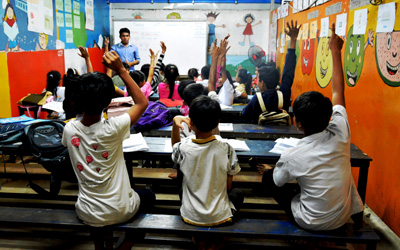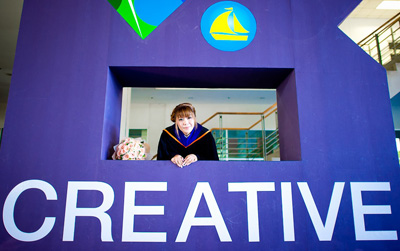Stuck in the doldrums
What with its less than stellar rankings on both the global and regional stage in overall educational indicators, Thailand has its work cut out ahead of the launch of the ASEAN Economic Community
Tibor Krausz
The Bangkok Post
The results are in and they ain’t pretty. According to the World Economic Forum’s “Global Competitiveness Report 2013-2014,” Thailand ranks at a dismal 8th place in the 10-member ASEAN grouping when it comes to its educational system’s suitability for meeting the needs of a competitive economy. The Kingdom finished even below its impoverished northern neighbor, Laos, and just above Cambodia.

Globally, the situation looks bleaker still. In the quality of its primary education the country ranks — steady yourself — at place 86 out of 148 countries. The overall ranking of Thailand’s educational system also places it squarely in mid-table, at 78th place out of the same 148 nations surveyed. Meanwhile, according to the most recent scores of the Programme for International Student Assessment (PISA), Thailand is sitting pretty in the bottom 25 percent — at 50th place out of 65 countries surveyed. The country’s then education minister Chaturon Chaisaeng declared himself “stunned” at the results.
Perhaps he should not have been. The Kingdom’s shortcomings in almost all areas of education are nothing new. In 2010, for instance, Thailand ranked 116th out of 163 countries on the global charts for the Test of English as a Foreign Language (TOEFL), landing among the bottom five countries even in Asia — together with Vietnam, Turkmenistan, Tajikistan and Timor-Leste (formerly East Timor). In general, Thai students did poorly equally on speaking, listening, writing and reading.
In response to the Kingdom’s poor standings, Sompong Jitradab, an assistant professor at Chulalongkorn University, pointed at widespread functional illiteracy among children, a problem that has plagued the country for decades. Yet, while neighboring countries, most of which lag behind Thailand in economic development, have managed to make inroads in education, Sompong said, Thailand has largely been stuck in a rut.
“Over the past four or five years, teams from other ASEAN countries have come to Thailand to look at how the education sector can be improved, and they’ve managed to deliver results. Yet Thailand is unable to solve its [own] educational problems,” he lamented.
Long story short: Thailand has one of the worst educational systems in the developed world and its educational achievements have little to recommend them even in Southeast Asia. The education minister who succeeded Sompong, Jaturon Chaisaeng, highlighted an “urgent need” to improve the quality of the country’s education ahead of the launch next year of the ASEAN Economic Community (AEC), an EU-style initiative that seeks to boost the region’s competitiveness on the global stage through closer collaboration in a variety of endeavors, with education among them.
The government has promised to expedite eight areas of development, including school reform, teacher training reform, improvement in vocational education, and a more equitable distribution of learning opportunities across the country.
Such reforms are certainly much needed. Last July the United Nations Conference on Trade and Development (UNCTAD) urged Thailand to upgrade its curricula, the better to enable students to compete better both at global job markets and in the AEC region with its aggregate population of 580 million people, a large majority of whom are young and ambitious with dreams of social mobility.
Getting squeezed from all sides
Ultimately, the failures of the country’s education system, if current trends continue, will hurt those that education seeks to benefit in the first place: young Thais. As has happened in the Eurozone with the continent’s far more open borders, AEC will considerably ease the movement of labor across the region. While this will open up whole new areas of business opportunity, it will also bring with it increased competition in the work force.

Skilled workers with a well-rounded and solid educational background will enjoy far greater employment opportunities than those without it. Singapore devotes far more resources to human resource development than does Thailand, and when it comes to high-end jobs Thai graduates will be at risk of losing out to job applicants from the city state as well as from Malaysia, China and other countries whose educational systems better equip students for a competitive global job market.
Meanwhile, even in lowlier service industry jobs local Thais will likely face increased competition from foreign workers flocking to the Kingdom in search of better-paying jobs from neighboring Cambodia, Laos and Myanmar. Migrant workers from these countries already account for a large part of labor in construction, certain service industry jobs and the country’s black market economy.
It does not help that Thailand invests precious little in science as well as in research and development, spending just 0.2 percent of its GDP on them — much less than the other economic powerhouses of the region: Singapore and Malaysia. Analysts warn that short of drastic reforms in education, Thailand may become trapped as a “middle-income” country, even as its poorer, less developed countries in the region, like Vietnam, catch up or overtake it.
We no speak English
The Kingdom clearly has its work cut out for it. Thailand’s educational system focuses on rote learning, which dissuades students from independent thinking and merely expects them to regurgitate prepackaged bits of data and information with nary a thought about their use, validity or importance.
The result is that Thai students tend to fare poorly on even basic general knowledge tests. And routinely, despite often learning English (and other languages) for years, they can barely communicate in the global lingua franca beyond speaking a jumbled pidgin variety of the tongue, if that.
Most foreign English teachers in the Kingdom are familiar with the peculiar phenomenon of Thai students who major in English at colleges and universities and yet can barely string a coherent sentence together in the foreign tongue, let alone communicate effectively in it. The best many Thai students manage is to shyly parrot pre-taught sentences, with “How are you? I am fine, thank you and you?” being the most common.
And that despite the fact that English has been a core subject in Thailand for decades. Invariably, the fault lies with the teachers themselves. A fairly recent study, in collaboration with Cambridge University, of Thai teachers of English found that a staggering 60 percent of them barely spoke the language adequately themselves; many of them could not speak it well enough to teach basic English even in primary school.
Often, for want of qualified teachers, members of faculty who could manage a few words in English had simply been pressed into service at English classes by school administrators. Not surprisingly, of the remaining 40 percent of teachers surveyed, half were teaching grades for which they were qualified. Overall, only a meager 3 percent of teachers had passable levels of fluency in English at all. In a final insult, at some primary schools students scored higher on random language tests than their teachers did.
Schools and educational authorities have set out to remedy the problem of poor language teaching standards by subjecting Thai teachers to more rigorous testing and training programs. They have also been working to hire more native English speakers. Both are worthwhile efforts. The latter, however, has been undermined somewhat by the inadequate screening of candidates at several institutions, which means that native speakers teaching English to Thai students at various ages often lack the necessary academic credentials and teaching qualifications for the job.
Slavishly obedient
Several experts have pinpointed some deeply embedded attitudes and cultural influences as the underlying causes that have stymied breakout progress in Thai education. These include rote learning, an old-fashioned yet still widely used teaching method that is generally guaranteed to stifle students’ creativity and deaden their interest in any subject for good.
Another is a cultural taboo against individual initiative that challenges the consensus. From an early age Thai children are usually dissuaded from being too “different,” which routinely involves any sign of excessive inquisitiveness. Traditionally trained teachers often discourage too much questioning in their pupils and place a premium instead on conformity to rules and established modes of thought.
“[Thai students] are kind of passive learners. Because they respect teachers, they have to be quiet, sitting, listening and jotting down — which is something teachers expect from them,” Aurapan Weerawong, vice president of International Relations at Srinakharinwirot University, explained in a media interview.
That sort of reverential attitude may befit a study room in a monastery but not so much a vibrant modern classroom.
To be sure, a healthy respect for authority figures may have certain beneficial social features. But a culture of creative exploration by inquisitive minds, which has underpinned modern progress in all human endeavors, is not one of them. Thai students are often afraid to challenge teachers even when the latter are demonstrably wrong for fear of making their educators “lose face,” which would amount to a major faux pas by the mores of Thai society. Likewise, students may also be averse to speaking up for fear of making mistakes and so losing face themselves.
And so the expectation of unquestioning obedience and regimented conformity hangs like a dead weight around the necks of many a young learner.
Coping with challenges
Thai educators and policymakers are well aware of the problems that have been bedeviling the country’s educational system. Some of these problems may be relatively easy to tackle; others may require years or decades of hard work. To cope with the changes that the AEC will bring to the Thai higher education sector, the Ministry of Education’s Office of Higher Education Commission (OHEC) has hit the ground running by laying out several strategies for short-term improvement.
The strategies include efforts to increase Thai graduates’ English language proficiency and professional skills for work in multicultural environments. They include initiatives to boost the quality of research, instruction and innovation at Thai colleges and universities. And they include projects to promote Thailand as a regional education hub for students from neighboring countries as well as from across the region. Such ambitious plans will entail reforming the teaching of foreign languages; boosting cultural exchange programs; and facilitating the mobility of students both “vertically” (moving abroad for a higher degree) and “horizontally” (studying abroad for a term or terms as part of a degree).
Efforts are also under way to revise and update local curricula according to international standards. Meanwhile, more and more educational institutions are also placing an emphasis on improving their students’ analytical and problem-solving skills to better equip them for the challenges of work in the international knowledge economy. Leading the pack is Chulalongkorn University, one of the Kingdom’s most prestigious institutions, which has launched several international study programs to prepare both its faculty and its students for the formation of the AEC next year with a special focus on areas of science, engineering, and health.
Other universities are seeking to boost the qualifications of teachers at various levels of tuition from kindergarten up. Suan Sunandha Rajabhat University has embarked on a project hand in hand with 14 primary schools aimed at improving the skills of teachers of English at those schools by help of training courses offered both through the university’s Foreign Language Center and its International College. English will become the official language of ASEAN next year so proficiency in the tongue will be increasingly required of Thai students, teachers and professionals alike.
In a further benefit to Thailand’s educators and students, the AEC will facilitate further academic conferences, symposia, study programs and cultural exchanges. All in all, plenty of exciting new developments lie in store for the Kingdom and many local educational institutions will need to face up to the challenges and opportunities ahead. Simply getting by with the same old habits that have proven to have failed the country’s students en masse will no longer do.